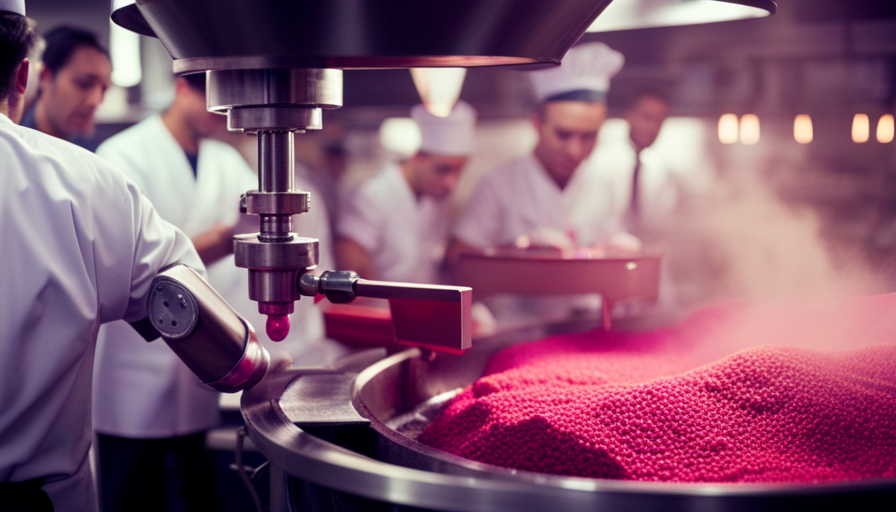Have you ever thought about where candle wax goes once it’s been lit? The journey is fascinating, showcasing the intricate chemistry that takes place during the burning of a candle. As a chemist, I’ve delved into the scientific principles behind this phenomenon and am excited to share my findings with you.
When we light a candle, the wax undergoes a series of transformations, transitioning from solid to liquid to gas. These phases occur due to the heat generated by the flame and the interaction between the wax, the wick, and the surrounding air.
The wax is drawn up the wick through capillary action, where it is vaporized and burned, releasing heat and light.
Understanding this process is not only intriguing but also crucial in maximizing candle efficiency and ensuring safety. Moreover, it’s essential to explore alternative candle options to minimize environmental impact.
In this article, we will delve into the chemistry of candle burning, the role of the wick and oxygen, the release of heat and light, and the environmental implications. Join me as we unravel the secrets of where the wax in a candle goes and discover the fascinating world of candle chemistry.
Key Takeaways
- The wax in a candle goes through a series of phases, including melting, vaporization, and combustion.
- During combustion, the wax reacts with oxygen to release heat and light, with the main products being carbon dioxide and water.
- The design of the wick and flame height determine the path of wax combustion, affecting the rate of wax consumption.
- Candle burning can impact indoor air quality and the environment, releasing soot particles and contributing to air pollution and the release of harmful chemicals.
The Chemistry of Candle Burning
As the candle burns, the wax magically transforms into a mesmerizing dance of vibrant flames and flickering light. This captivating process is driven by the understanding of combustion reactions.
When the heat from the flame reaches the solid wax, it causes the wax to melt and vaporize. These vapors then react with the oxygen in the air, resulting in a chemical reaction known as combustion. The main products of this reaction are carbon dioxide (CO2) and water (H2O), along with some trace amounts of other gases and soot particles.
The combustion of wax is an exothermic reaction, meaning it releases heat energy. This heat further sustains the combustion process, allowing the flame to continue burning. The release of carbon dioxide is an important aspect of candle burning. It is this gas that contributes to the vibrant flames we see. As the carbon atoms in the wax vapor combine with oxygen, they form carbon dioxide gas, which is responsible for the blue portion of the flame.
Understanding the phases of candle burning is crucial in comprehending where the wax goes. It involves the transformation of solid wax into liquid and gaseous forms, followed by the combustion of these gaseous wax molecules. This process ensures that the wax is fully utilized, leaving behind minimal residue.
Understanding the Phases of Candle Burning
In understanding the phases of candle burning, there are three key points to consider.
First, the melting of the wax occurs as the heat from the flame is transferred to the solid wax, causing it to turn into a liquid.
Second, the liquid wax then vaporizes as the heat continues to increase, resulting in the formation of a gaseous phase.
Finally, the vaporized wax undergoes combustion as it reacts with oxygen in the air, producing heat and light.
Melting of the Wax
When the candle burns, the wax melts and transforms into a liquid state. This process of melting occurs due to the heat generated by the flame. The melting point of wax varies depending on the type of wax used, but generally falls between 110 to 150 degrees Fahrenheit. As the heat from the flame is applied to the solid wax, the temperature rises and surpasses the melting point, causing the wax to change from a solid to a liquid. This phase transition is an important step in the overall combustion process of the candle. Once the wax has melted, it enters the next stage of the burning process, where it vaporizes and combines with oxygen to produce heat, light, water vapor, and carbon dioxide.
Vaporization of the Liquid Wax
After the wax has melted, you’ll see it transform into a vapor as it combines with oxygen to create heat and light.
The vaporization process occurs when the liquid wax reaches its boiling point and turns into a gas. This is a result of the wax molecules gaining enough energy to overcome the forces holding them together.
Once in the gas phase, the wax molecules mix with the surrounding air, creating a mixture of vaporized wax and oxygen. This mixture is highly flammable and can ignite when exposed to a flame or spark, leading to combustion.
The wax evaporation is a crucial step in the candle’s burning process, allowing the wax to release energy in the form of heat and light.
Combustion of the Vaporized Wax
The vaporized wax combines with oxygen and transforms into a highly flammable mixture, ready to be ignited and release energy in the form of heat and light. During the phases of combustion, the vaporized wax undergoes a series of chemical reactions.
First, it breaks down into smaller hydrocarbon molecules, such as carbon dioxide and water vapor. These reactions release heat, which sustains the combustion process. As the wax continues to burn, more oxygen is drawn in through the wick, providing a constant supply of fuel for the flame. This continuous supply of wax vapor and oxygen ensures that the combustion process remains steady.
Throughout this process, the wax is gradually consumed, converting into gaseous byproducts. This transformation is essential for the candle to continue burning. Moving on to the role of the wick, it plays a crucial role in the combustion process.
The Role of the Wick
You may be surprised to learn that the wick in a candle plays a crucial role in determining where the wax goes. The design of the wick and the height of the flame are key factors in this process.
Wick Design:nnThe size and material of the wick affect how much wax is drawn up and burned. A larger wick will draw up more wax, resulting in a larger flame and faster burn rate.nnThe shape of the wick also influences the flow of melted wax. A twisted or braided wick creates capillary action, drawing the liquid wax upward.
Flame Height:nnThe height of the flame is determined by the amount of fuel being burned. A taller flame indicates a higher rate of wax consumption.nnIf the wick is too long, the flame can become too large, leading to excessive wax being consumed and wasted.
These factors work together to determine where the wax goes during combustion. The wick design and flame height directly affect the rate of wax consumption and can result in uneven burning or dripping. Understanding the role of the wick helps explain why some candles burn more efficiently than others.
Transitioning into the subsequent section about the role of oxygen in candle burning, we can explore how the availability of oxygen impacts the combustion process.
The Role of Oxygen in Candle Burning
Imagine being able to control the intensity and duration of your candle’s flame simply by adjusting the amount of oxygen it receives. Oxygen plays a crucial role in the burning process of a candle.
As the flame burns, it consumes oxygen from the surrounding air. This process, known as oxygen consumption, is essential for the candle to continue burning. The availability of oxygen directly affects the size and color of the flame. When there is a limited oxygen supply, the flame becomes smaller and flickers. On the other hand, when there is an abundant supply of oxygen, the flame burns brighter and steadier.
The color of the flame also changes with the amount of oxygen present. A well-oxygenated flame tends to have a blue color, indicating complete combustion. In contrast, a flame with limited oxygen appears more yellow or orange due to incomplete combustion.
Understanding the role of oxygen in candle burning allows us to manipulate the flame’s characteristics by controlling its oxygen supply. This brings us to the next section, where we will explore the release of heat and light.
The Release of Heat and Light
In the previous subtopic, we discussed the role of oxygen in candle burning. Now let’s dive into the current subtopic, which is the release of heat and light during the burning process.
When a candle burns, it undergoes a series of chemical reactions that result in the release of energy. This energy is primarily in the form of heat and light. The main component of a candle, the wax, serves as the fuel for these reactions.
As the heat from the flame melts the wax near the wick, it’s drawn up the wick and vaporized. This vapor then reacts with the oxygen in the air, producing carbon dioxide and water vapor. The heat generated during these reactions sustains the flame and keeps the process going.
The release of light occurs when the heated particles in the flame emit energy in the form of visible light. This process is known as incandescence.
To summarize, the burning of a candle involves the release of energy through chemical reactions, resulting in the production of heat and light. Now, let’s explore where exactly the wax goes during this process.
Where Does the Wax Go?
When a candle burns, the wax is consumed by the flame, undergoing a chemical reaction called combustion. This process releases heat and light, but also produces byproducts such as carbon dioxide and water vapor.
Additionally, as the wax burns, residue and soot can form, which may adhere to surfaces near the candle.
Consumption of the Wax
Did you know that when you burn a candle, the wax actually gets consumed in the process? The consumption of wax during the burning of a candle is a fascinating phenomenon to study. Wax depletion occurs as the heat from the flame melts the solid wax, turning it into a liquid.
This liquid wax is then drawn up the wick through capillary action, where it undergoes combustion. As the wax burns, it releases heat and light energy. The heat further melts the wax, sustaining the burning process. Over time, the wax level decreases, indicating the consumption of the wax.
Understanding the consumption of wax is crucial for candle makers and enthusiasts alike. Now, let’s explore the byproducts of candle burning to gain a comprehensive understanding of the entire process.
The Byproducts of Candle Burning
After the consumption of the wax, another important aspect to consider is the byproducts that are generated during the burning process. These byproducts can have a significant impact on both the environment and indoor air quality.
-
Soot: When a candle burns, it produces tiny, black particles called soot. These particles can be released into the air and settle on surfaces, causing potential health issues and respiratory problems.
-
Residue formation: As the candle burns, some of the wax can be left behind in the form of residue. This residue can accumulate on the candle holder, surrounding surfaces, and even on walls, requiring regular cleaning and maintenance.
-
Environmental impact: The burning of candles contributes to air pollution by releasing harmful chemicals and greenhouse gases. This can have adverse effects on the environment, including air quality degradation and climate change.
Transitioning into the next section, the residue and soot formation play a crucial role in understanding the complete picture of where the wax goes after burning.
Residue and Soot Formation
To truly understand the impact of burning candles, picture the residue and soot that form, coating surfaces and lingering in the air around you. These byproducts are not only unsightly but can also pose health risks. Residue prevention and soot reduction are key considerations when it comes to candle usage.
To illustrate the extent of the issue, consider the following table:
| Surface | Residue (grams) | Soot (micrograms) |
|---|---|---|
| Walls | 4.2 | 2.8 |
| Furniture | 2.9 | 1.5 |
| Curtains | 1.6 | 1.2 |
| Air (per hour) | 7.1 | 4.6 |
These numbers highlight the importance of taking measures to minimize residue and soot. Regularly cleaning surfaces, using candles with lower soot emission, and ensuring proper ventilation are effective ways to mitigate these effects.
Transitioning into the subsequent section about the environmental impact of candle burning, it is crucial to understand the broader implications beyond just residue and soot.
The Environmental Impact of Candle Burning
The wax in a candle goes beyond providing ambient lighting; it’s worth considering its environmental impact. Candle burning releases various pollutants into the air, including particulate matter, volatile organic compounds (VOCs), and greenhouse gases. These pollutants contribute to air pollution, which can have detrimental effects on human health and the environment.
To better understand the environmental impact of candle burning, let’s explore two subtopics:
-
Particulate Matter: Candle combustion produces tiny particles that can be inhaled, leading to respiratory issues. These particles can also settle on surfaces, creating a layer of soot that requires cleaning. This can be particularly problematic for individuals with respiratory conditions.
-
Sustainable Alternatives: To minimize the environmental impact, consider using sustainable alternatives to traditional candles. Beeswax candles are a great option as they’re made from natural and renewable resources. Soy candles are another sustainable alternative that burns cleaner and emits fewer pollutants compared to paraffin candles.
Considering the environmental impact of candle burning, it’s essential to explore sustainable alternatives and make conscious choices.
In the subsequent section about maximizing candle burning efficiency, we’ll discuss tips to reduce wastage and optimize the lifespan of candles.
Tips for Maximizing Candle Burning Efficiency
Maximize the lifespan of your candles and save money by following these tips for efficient candle burning. Trim the wick to ¼ inch before lighting, which can increase burn time by up to 30%.
Additionally, ensure that the first burn of your candle lasts long enough to create a full melt pool, which is when the wax reaches the edges of the container. This will help prevent tunneling, where the wax only melts in the center and leaves unused wax along the sides.
To further increase the candle burning time and reduce wax waste, it’s important to keep the candle away from drafts, as they can cause uneven burning and excessive dripping. Place your candle on a flat, heat-resistant surface to maintain an even burn.
Additionally, avoid burning your candle for more than four hours at a time as this can lead to excessive heat and potentially cause the container to crack.
By implementing these efficient candle burning tips, you can enjoy longer-lasting candles and minimize wax waste. Now, let’s explore some essential candle safety precautions to ensure a worry-free candle burning experience.
Candle Safety Precautions
When it comes to candle safety, there are three key points to keep in mind: fire safety measures, preventing accidental fires, and safe candle usage.
Fire safety measures involve having a fire extinguisher nearby, keeping candles away from flammable objects, and never leaving a burning candle unattended.
Preventing accidental fires includes ensuring that the candle is placed on a stable surface, away from drafts, and keeping it out of reach of children and pets.
Lastly, safe candle usage involves trimming the wick to a quarter of an inch, using a candle snuffer to extinguish the flame, and never using a candle that is cracked or damaged.
Fire Safety Measures
To keep yourself safe, make sure you know where the wax in a candle goes. Fire prevention and candle maintenance are crucial in ensuring your safety.
When a candle burns, the wax is converted into heat, light, water, and carbon dioxide. The heat and light provide illumination and ambiance, while the water and carbon dioxide are released into the air. However, if the candle is not maintained properly, the wax can accumulate and create a fire hazard.
It’s important to trim the wick to a quarter of an inch before lighting the candle to ensure a controlled burn. Additionally, always keep the candle away from flammable materials and never leave it unattended.
By following these fire safety measures and practicing proper candle maintenance, you can prevent accidental fires.
Preventing Accidental Fires
Ensure your safety by preventing accidental fires. Fire prevention is crucial when it comes to candle usage.
One important aspect of fire prevention is proper candle storage. It’s essential to keep candles away from flammable materials such as curtains, paper, or clothing. Store candles in a cool, dry place, away from direct sunlight or heat sources.
Additionally, always ensure that candles are placed on stable, heat-resistant surfaces and are kept at a safe distance from any combustible materials. It’s also important to avoid placing candles near drafts or in areas where they can be easily knocked over.
By following these fire prevention measures and practicing safe candle usage, you can enjoy the cozy ambiance of candles without risking accidental fires.
Safe Candle Usage
Properly storing and placing candles reduces the risk of accidental fires, but what can we do to enhance the cozy ambiance they create? Safe handling and proper storage are key factors in ensuring the safety of candle usage. To help you understand the importance of these practices, let’s take a look at the following table:
| Safe Handling Tips | Proper Storage Tips |
|---|---|
| Always trim the wick before lighting | Store candles in a cool, dry place |
| Never leave a burning candle unattended | Keep candles away from direct sunlight |
| Use a sturdy and heat-resistant candle holder | Avoid storing candles near flammable materials |
By following these guidelines, you can minimize the risk of accidents and enjoy the warm glow of candles safely. Now, let’s explore alternative candle options without skipping a beat.
Exploring Alternative Candle Options
Beeswax candles, soy candles, and LED flameless candles are all alternative options to traditional wax candles.
Beeswax candles are a popular choice due to their natural and eco-friendly properties, as well as their long burn time and clean fragrance.
Soy candles are another great option, as they’re made from renewable soybean oil and produce less soot and toxins when burned.
Lastly, LED flameless candles provide a safe and convenient alternative, as they don’t produce flames or heat and can be easily controlled with a remote.
Beeswax Candles
Did you know that beeswax candles aren’t just beautiful, but they also burn longer than other types of candles? Beeswax is a natural substance produced by bees during honey production. Beeswax production is a complex process that involves the secretion of wax scales by worker bees, which are then chewed and molded into hexagonal cells within the hive.
There are several benefits to using beeswax candles. Firstly, they emit a natural, sweet aroma that can enhance relaxation and promote a sense of calm. Secondly, beeswax candles produce a bright, steady flame that emits a warm and pleasant light. Lastly, beeswax candles are known for their long burn times, which can be attributed to the high melting point of beeswax.
Now, let’s transition into the subsequent section about soy candles and explore their unique characteristics.
Soy Candles
If you’re looking for a more environmentally-friendly and sustainable option, soy candles are a fantastic choice. They offer numerous benefits compared to traditional paraffin candles.
First and foremost, soy candles are made from soybean oil, a renewable resource that’s biodegradable. This means they have a lower carbon footprint and are less harmful to the environment.
Additionally, soy candles burn cleaner and produce less soot and smoke compared to paraffin candles. They also tend to have a longer burn time, making them more cost-effective in the long run.
Another advantage of soy candles is that they have a lower melting point, which means they last longer and provide a more even burn.
Transitioning to the subsequent section about ‘led flameless candles’, let’s explore another alternative to traditional wax candles.
LED Flameless Candles
One advantage of LED flameless candles is that they offer a safer alternative to traditional wax candles, reducing the risk of accidental fires and providing peace of mind. These candles use LED lights to mimic the flickering effect of a real flame, without the need for an actual flame. This eliminates the risk of the candle being knocked over or coming into contact with flammable materials. Additionally, LED flameless candles do not produce any heat, so there is no risk of burns. They are also more energy-efficient, lasting much longer than traditional candles. However, there are a few drawbacks to consider. LED flameless candles may not provide the same ambiance as real candles and they do require batteries, which need to be replaced periodically. Overall, LED flameless candles are a practical and safe choice for those looking to enjoy the beauty of candles without the risks.
| Pros | Cons |
|---|---|
| Safer alternative to traditional candles | May not provide the same ambiance as real candles |
| Reduces the risk of accidental fires | Requires batteries that need to be replaced periodically |
| No risk of burns | |
| Energy-efficient and long-lasting |
Frequently Asked Questions
How long does a typical candle last before it completely burns out?
The burning time of a typical candle before it completely burns out can vary depending on several factors such as the size of the candle, the type of wax used, and the burning conditions. On average, a typical candle can last anywhere from 1 to 4 hours. However, by reusing leftover wax and using certain techniques like trimming the wick, the burning time can be extended, resulting in a more efficient use of the candle.
Can I reuse the leftover wax from a burned-out candle?
Yes, you can reuse the leftover wax from a burned-out candle. Reusing wax is a common practice in candle making. By melting the leftover wax and filtering out any debris, it can be used to create new candles.
This process not only reduces waste but also saves money. Reusing wax is a sustainable approach that many candle makers employ to create new and unique candles.
Are scented candles more harmful to the environment than unscented candles?
Scented candles have a greater environmental impact compared to unscented candles due to the presence of fragrance chemicals. These chemicals can be derived from petroleum and release volatile organic compounds (VOCs) when burned, contributing to air pollution. Additionally, scented candles often require more resources and energy for production.
Therefore, choosing unscented candles can be a more environmentally friendly option, as they have a lower potential for releasing harmful chemicals and have a lesser overall impact on the environment.
Can I use a candle to remove unwanted odors from my home?
Using a candle as a home fragrance is a popular choice, but it’s important to note that candle wax doesn’t remove unwanted odors from your home. Instead, it emits fragrance oils that can help mask or overpower unpleasant smells. When the candle burns, the heat causes the wax to melt and release these fragrance oils into the air. So while candles can provide a pleasant scent, they don’t actually eliminate odors.
Are there any health risks associated with burning candles indoors?
There are potential health risks associated with burning candles indoors. Studies have shown that burning candles can release harmful pollutants such as benzene and formaldehyde, which can negatively impact indoor air quality and respiratory health.
However, there are alternatives available such as using electric candles or essential oil diffusers, which provide similar ambiance without the health risks.
It’s important to consider these alternatives for the health benefits they offer.
Conclusion
In conclusion, understanding the chemistry of candle burning is crucial for maximizing efficiency and reducing environmental impact. By comprehending the phases of candle burning, the role of the wick, the importance of oxygen, and the release of heat and light, we can ensure that we make the most of our candles.
Additionally, exploring alternative candle options can further enhance our candle-burning experience. Remember, knowledge is power, and when it comes to candles, knowledge can help us burn the candle at both ends, achieving the desired ambiance while minimizing waste.










